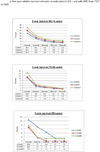Outcome of older patients with acute myeloid leukemia: an analysis of SEER data over 3 decades
- PMID: 23633441
- PMCID: PMC3821042
- DOI: 10.1002/cncr.28129
Outcome of older patients with acute myeloid leukemia: an analysis of SEER data over 3 decades
Abstract
Background: Acute myeloid leukemia (AML) is the common form of acute leukemia in adults, accounting for over 80% of all acute leukemias in individuals aged >18 years. Overall 5-year survival remains poor in older AML patients; it is <5% in patients aged >65 years. In this study, the authors examined whether survival has improved for subsets of geriatric AML patients over 3 successive decades.
Methods: Surveillance, Epidemiology and End Results (SEER) data were used to determine trends in relative survival by age among 19,000 patients with AML over 3 successive decades (1977-1986, 1987-1996, and 1997-2006). Relative survival rates (RRs) with 95% confidence intervals (CIs) were calculated as measures of survival.
Results: Overall, the RRs increased for each successive decade (1977-1986, 1987-1996, and 1997-2006) in patients ages 65 to 74 years, with improvements in 12-month survival from 20%, to 25%, to 30%, respectively. Findings were similar for 24-month, 36-month, 48-month, and 60-month survival. However, survival rates did not improve in patients aged ≥75 years. The oldest old patients (aged ≥85 years) had the lowest survival rates, with no apparent improvement.
Conclusions: This analysis of a large data set demonstrated that, although overall survival remained unsatisfactory among older patients, it improved in the younger old (ages 65-74 years). Survival of older old AML patients has not been favorably impacted by available AML therapies or supportive care, and intervention in this age group is best undertaken on a clinical trial.
Keywords: Surveillance, Epidemiology and End Results data; acute myeloid leukemia; age; survival.
© 2013 American Cancer Society.
Conflict of interest statement
Conflict-of-Interest disclosure: The authors declare no competing financial interests
Figures




References
-
- Siegel R, Naishadham D, Jemal A. Cancer statistics, 2012. CA Cancer J Clin. 2012;62:10–29. - PubMed
-
- Estey E, Dohner H. Acute myeloid leukaemia. Lancet. 2006;368:1894–1907. - PubMed
-
- Phekoo KJ, Richards MA, Moller H, Schey SA. The incidence and outcome of myeloid malignancies in 2,112 adult patients in southeast England. Haematologica. 2006;91:1400–1404. - PubMed
-
- Burnett A, Wetzler M, Lowenberg B. Therapeutic advances in acute myeloid leukemia. J Clin Oncol. 2011;29:487–494. - PubMed
-
- Lichtman MA. A historical perspective on the development of the cytarabine (7days) and daunorubicin (3days) treatment regimen for acute myelogenous leukemia: 2013 the 40th anniversary of 7+3. Blood Cells Mol Dis. 2013;50:119–130. - PubMed
Publication types
MeSH terms
Grants and funding
LinkOut - more resources
Full Text Sources
Other Literature Sources
Medical

